What Is Bandwidth in Networking, How Is It Measured?
Slow downloads, laggy games, and video buffering don’t always mean you have problems with the internet service provider (ISP) or WiFi network. Often, it comes down to bandwidth limits. While the concept can seem a bit technical, this guide breaks it down into simple terms.
What is bandwidth? Bandwidth refers to how much data your network can handle at one time. If your bandwidth is limited, it can lead to slower speeds and a less enjoyable online experience. But don’t worry — this article will walk you through how to measure your bandwidth and avoid common issues like throttling and other bottlenecks. It also clears up the difference between network bandwidth and the monthly data limits set by your ISP or carrier.
What Is Bandwidth
Network bandwidth is your internet’s maximum data transfer capacity in a given period. It’s usually measured in megabits per second (Mbps). Imagine it as a highway — the more lanes (bandwidth) there are, the more cars (data packets) can travel at the same time. For example, a 100Mbps connection allows you to transfer up to 100 megabits of data every second.
Different types of connections handle bandwidth in various ways. Business connections often use symmetrical bandwidth (where upload and download speeds are equal) because they’re crucial for activities like server hosting or constant video conferencing.
In contrast, most home connections are asymmetrical, prioritizing downloads over uploads. For instance, a typical home plan might offer 100Mbps download speeds but only 20Mbps upload, which is sufficient for tasks like UHD streaming or casual browsing. The reason this is the case is because most users usually download more than they upload.
However, bandwidth isn’t the same as data caps, and this distinction is important. Bandwidth determines how quickly data can flow through your network at any moment, while data caps limit the total amount of data you can use over a period (like a month), regardless of your total bandwidth. For example, a 1TB data cap means you can download about 1,000 gigabytes before your provider imposes restrictions.
Here’s where things can overlap: some ISPs and mobile carriers tie bandwidth to monthly usage limits. If you exceed these limits, your speeds might be throttled, and you could face extra charges or even a temporary service suspension.
Generally though, bandwidth affects the speed of your connection, while data caps determine how much you can use it. Understanding both can help you make better choices about your internet plan and avoid surprises on your bill.
Misconceptions About Network Bandwidth
A common misconception is that more bandwidth equals faster internet speeds. Many confuse bandwidth with speed, latency, and throughput. These terms relate but describe different network aspects.
Let’s break down these key networking terms:
- Bandwidth capacity. The maximum data flow your network allows at once. A 100Mbps connection can transfer up to 100 megabits per second — but the speed depends on your internet connection and plan.
- Internet speed. Measures how quickly data packets are delivered to your device. Even with high bandwidth, actual speeds can vary due to network conditions. More lanes (bandwidth) don’t make cars go faster — they let more cars travel at once.
- Network latency. The delay between sending and receiving data. If bandwidth is lanes, latency is travel time from point A to B. Lower latency means more responsive gaming and video calls.
- Data throughput. This refers to the actual amount of data successfully transferred over a network, accounting for real-world conditions. A 100Mbps connection may not actually deliver 100 megabits of data per second due to issues like network congestion or packet loss.
- Monthly bandwidth caps. Total data usage limits per billing cycle. Caps restrict how much you can transfer before penalties or speed reductions.
How to Measure Internet Bandwidth
Internet bandwidth is measured by the amount of data transferred over a network within a specific time frame. Modern connections are measured in megabits (Mbps) or gigabits (Gbps) per second. For context, 1Mbps is enough to load a basic webpage in just a few seconds.
Different online activities require varying amounts of bandwidth. The average bandwidth needs are:
- 25Mbps for streaming 4K videos
- 25-100Mbps for online gaming
- 2-6Mbps for video conferencing
- 1Mbps for fast web browsing
You can use a combination of tools to measure your network bandwidth capacity for free. The following free tools display detailed statistics on network activity:
- Online testers like nPerf and BandwidthPlace let you assess download and upload speeds, as well as your ping.
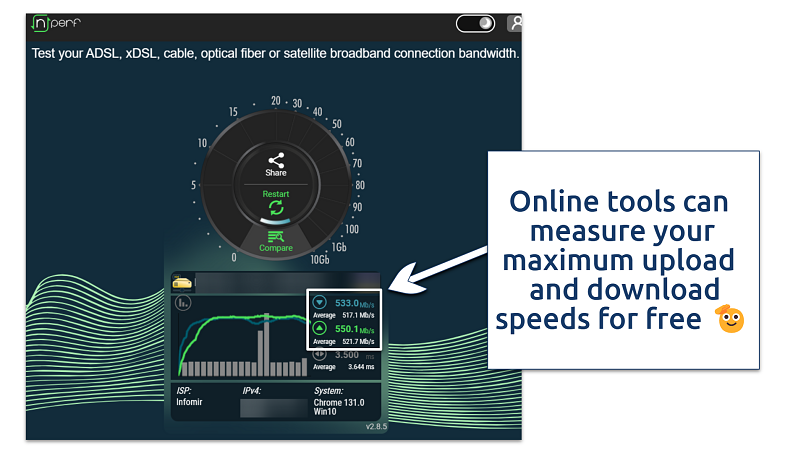 nPerf gauged my bandwidth capacity, letting me see my speed limits
nPerf gauged my bandwidth capacity, letting me see my speed limits
- Windows’ Task Manager, MacOS’ Activity Monitor, and Linux commands (such as iftop, nload, and bmon) can monitor network usage and adapter information.
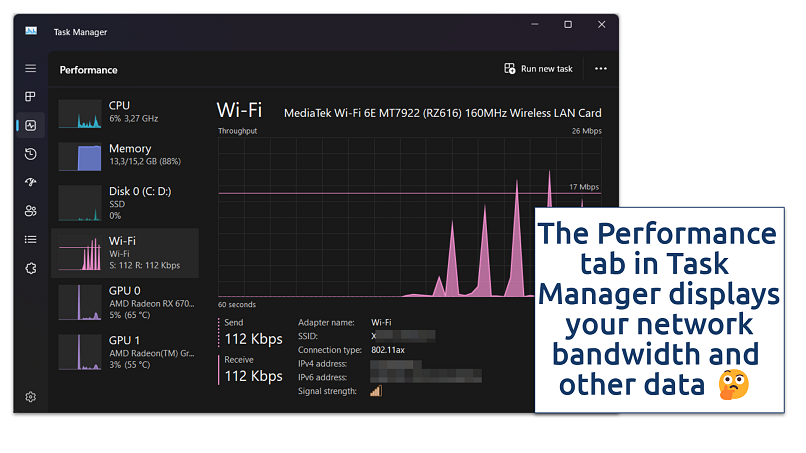 Press Ctrl+Alt+Delete to enter Task Manager on Windows, or find Activity Monitor in Mac’s Utilities
Press Ctrl+Alt+Delete to enter Task Manager on Windows, or find Activity Monitor in Mac’s Utilities
- Advanced software like SolarWinds NetFlow Traffic Analyzer and NetLimiter can monitor traffic patterns and identify bottlenecks, but they’re rarely used by average home users.
Why Bandwidth Matters for Your Internet Connection
Higher bandwidth capacity allows multiple users to perform data-intensive activities simultaneously. It enables:
- Faster file downloads and uploads
- Higher quality video streaming
- Smoother video conferencing
- Multiple simultaneous high-data activities
- Better online gaming experience
- Quicker cloud service access
When your bandwidth is insufficient for these activities, you’ll experience buffering, pixelated video, slow downloads, and general performance issues during peak usage times.
Even though global internet bandwidth increased by 22% in 20241, Deloitte predicts that at least 80% of these applications won’t need higher internet speeds between 2024 and 2025. In fact, some might require less bandwidth, thanks to better compression technology2.
Over the 2010s, the rise of online video led to a big surge in internet demand. Today, however, most households find speeds of around 100Mbps sufficient for their everyday activities. This slowdown in demand isn’t just due to a lack of new bandwidth-hungry apps or devices — it’s also tied to changes in household sizes.
While larger families with 3 or more children and two parents tend to need more bandwidth, they make up less than 5% of households. The majority of homes now have just 1 or 2 adults, and in 2025, single-adult households are expected to become the most common type3. Smaller households naturally require less bandwidth, contributing to the overall slowdown in demand growth.
Factors That Affect Your Bandwidth
Bandwidth quality depends on various factors, from your internet setup to how your network is managed. Let’s break down the key elements that influence your bandwidth and explore practical ways to improve it.
Network Infrastructure
Your ISP’s infrastructure forms the backbone of your connection. Fiber-optic networks can deliver speeds up to 10Gbps, whereas older copper DSL lines often max out at 100Mbps. Even within the same area, the quality of infrastructure can differ significantly based on how recently it was installed.
Networking Devices
Your devices can limit your bandwidth. For instance, an outdated router with 802.11n WiFi won’t support a gigabit fiber connection’s full potential. Upgrading to modern routers, like those with WiFi 6, can significantly improve speeds. For example, after replacing a basic ISP router with a WiFi 6 model, my speeds increased by nearly 30%.
Simultaneous Users and Devices
Every connected device uses some of your bandwidth. A typical household may have 15-20 devices, from smartphones to smart home gadgets, all competing for the same connection. This can lead to slowdowns when multiple users stream videos, play games, or make video calls simultaneously.
To estimate your bandwidth needs, list your applications and their requirements. For example, a UHD Netflix stream, online gaming, and a video call may need around 38Mbps combined. Adding a 20% buffer ensures smooth performance for background tasks.
Network Hogs
Outdated devices, overloaded routers, or users downloading large files can disproportionately consume bandwidth. Silent processes, like automatic updates or cloud syncs, can also slow down your network. Identifying and limiting such “network hogs” can free up bandwidth for other activities.
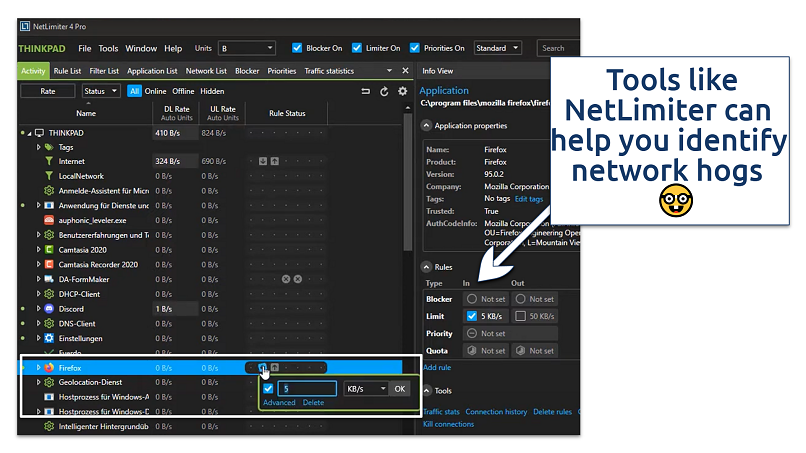 After identifying bottlenecks, you can limit bandwidth for specific users or programs
After identifying bottlenecks, you can limit bandwidth for specific users or programs
Congestion, Packet Loss, & Latency
Bandwidth issues can also stem from technical challenges in your network:
- Congestion: Slower speeds during peak hours are common in high-traffic areas.
- Packet loss: Dropped data packets reduce throughput and may require retransmissions.
- Latency: Delays in data transfer affect gaming, video calls, and other interactive apps.
- Jitter: Inconsistent speeds can disrupt real-time applications like streaming and conferencing.
Physical Interference
Physical factors, such as your distance from the router, walls, or interference from other devices, can reduce bandwidth. For instance, thick concrete walls may cut WiFi signal strength in half. Additionally, overcrowding on 2.4GHz or 5GHz WiFi channels can create interference, further affecting performance.
ISP Throttling
Some ISPs intentionally slow down your connection during peak hours or limit speeds for specific activities like streaming. This is often part of traffic management policies aimed at reducing strain on their networks.
Tips for Optimizing Your Bandwidth to Avoid Bottlenecks
Effective bandwidth management can significantly enhance your online experience. Here are some practical tips to help you optimize your bandwidth and avoid bottlenecks:
- Upgrade your internet plan. Assess whether your current plan meets your needs. For example, streaming 4K content smoothly requires at least 25Mbps. Households with multiple users may benefit from fiber-optic or 5G plans offering higher speeds.
- Optimize network equipment. Replace outdated routers with models that support WiFi 6. Dual-band or tri-band routers operating at 5GHz can manage traffic more efficiently. Position your router centrally and away from physical obstructions to ensure optimal signal distribution.
- Adjust WiFi channel width. In the 5GHz band, increasing channel width can enhance performance, provided there’s minimal interference. However, in the 2.4GHz band, it’s advisable to stick with 20MHz channels to reduce interference.
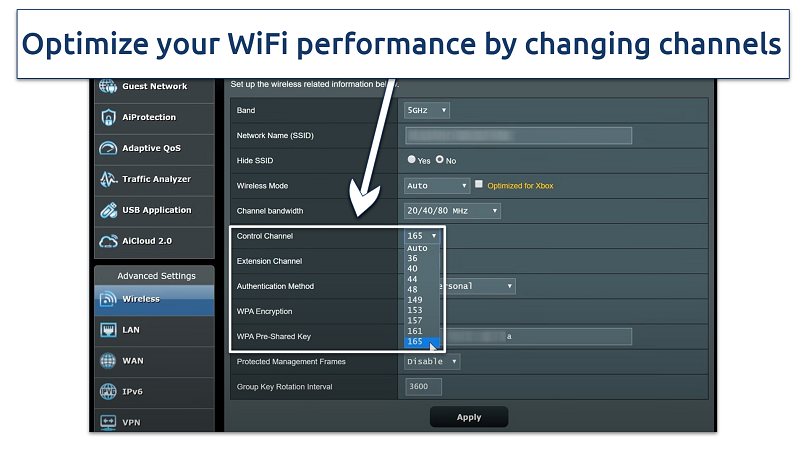 Access your router’s admin panel to adjust the control channel settings for better bandwidth
Access your router’s admin panel to adjust the control channel settings for better bandwidth
- Use wired connections. Connect stationary devices like desktops and smart TVs directly via Ethernet cables. Wired connections offer stable speeds and free up wireless bandwidth for mobile devices.
- Configure network settings. Enable Quality of Service (QoS) on your router to prioritize critical applications, such as video calls. Set bandwidth limits for specific devices or apps to prevent any single user from monopolizing the connection.
- Monitor bandwidth consumption. Utilize network monitoring tools to track which devices and applications consume the most bandwidth. Set up alerts for unusual spikes to identify and address potential bottlenecks promptly.
- Schedule demanding tasks. Perform large downloads, updates, and backups during off-peak hours. Coordinate with household members to avoid simultaneous high-bandwidth activities.
- Deploy bandwidth control tools. Consider using software like NetLimiter to manage and restrict bandwidth usage for specific applications, preventing background processes from interfering with essential tasks.
- Consider flexible bandwidth solutions. Explore services that offer temporary bandwidth increases for special events or peak periods. Some providers offer dynamic allocation that adjusts based on real-time demand.
- Use a reliable VPN like ExpressVPN to prevent throttling. ISPs often reduce bandwidth for certain activities or websites. A VPN encrypts your data, concealing your online activities from your ISP, which helps prevent such throttling.
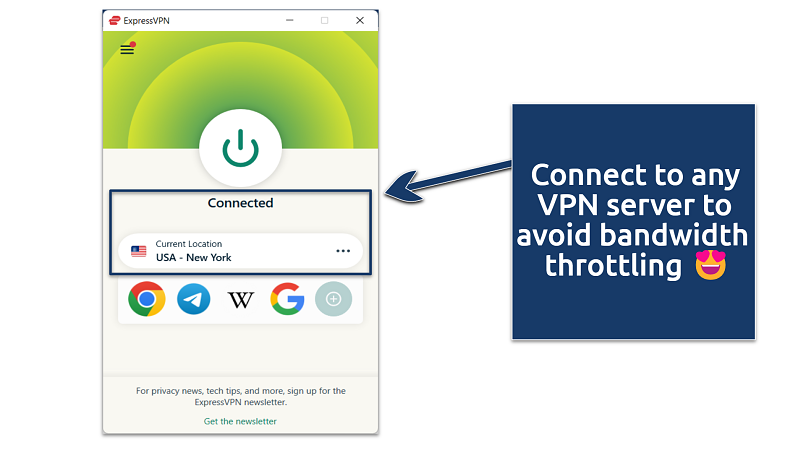 When connected, ISPs can’t see your online activity, and are less likely to throttle your speeds
When connected, ISPs can’t see your online activity, and are less likely to throttle your speeds
Want to learn more about how VPNs can improve your online activity? Check out our detailed guides:
- Best VPN for torrenting — safely download and share files on networks that reduce torrenting speeds.
- Top VPNs for UHD streaming — these VPNs work with popular platforms and support 4K streaming.
- Best gaming VPNs — play without lags, change worldwide servers, and get improved protection against DDoS attacks.
FAQs on Network Bandwidth
How is bandwidth different from internet speed, latency, and throughput?
Bandwidth refers to your network’s maximum data capacity, while speed measures how quickly data moves through the network. Think of bandwidth as the number of lanes on a highway — more lanes (higher bandwidth) allow more cars (data) to travel simultaneously, but it doesn’t make the cars themselves move faster (speed).
Latency, on the other hand, is the delay between sending and receiving data, like a lag in response time. Throughput is the actual amount of data successfully transferred over the network, accounting for losses due to congestion or other issues.
Do I need high or low bandwidth?
Higher bandwidth allows for smoother internet performance, especially when multiple devices or users are active. However, you don’t need excessive bandwidth beyond your actual requirements. You can calculate your bandwidth needs based on your typical activities, the number of users, and connected devices.
By matching your bandwidth to your household’s usage patterns, you can avoid overpaying for unnecessary capacity while ensuring reliable performance.
How much is 1GB of bandwidth?
1GB equals approximately 1,000MB of data transfer capacity. Understanding your data usage will help you avoid hitting bandwidth caps. Here’s what you can typically do with 1GB of bandwidth:
- Send or receive about 6,000 emails with small attachments.
- Browse standard websites for approximately 15–20 hours (depending on the content and media on the pages).
- Participate in a one-hour video call, which consumes around 500–700MB, depending on the platform and video quality.
Can a VPN increase my internet bandwidth?
VPNs can’t increase your actual bandwidth capacity, as this is determined by your internet service plan and network infrastructure. However, a VPN can improve your speeds in cases of ISP throttling. ISPs often reduce speeds for specific activities, like streaming or gaming, but a VPN encrypts your data and hides your activities. VPNs prevent your ISP from identifying and selectively slowing down certain traffic.
That said, using a VPN usually introduces a small speed reduction due to the encryption process and rerouting through a server. High-quality VPN providers with fast, optimized networks can minimize this impact, reducing speeds by less than 10%, whereas less reliable services may cut your speeds by 50% or more.
Conclusion
Bandwidth doesn’t directly determine your internet speed but acts as the upper limit for how much data can flow through your network at a given time. The amount of bandwidth you need depends on your activities — basic browsing requires far less than activities like 4K streaming, online gaming, or running cloud-based business applications.
Improving your online experience doesn’t always require upgrading your internet plan or equipment. Effective monitoring, optimizing network settings, and managing bandwidth allocation can help you make the most of your existing resources, ensuring smooth performance even for bandwidth-intensive tasks.
References:
React to this headline: